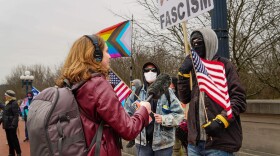On a recent September afternoon, I climbed into a canoe on the shores of Louisville — and pushed off onto the Ohio River Way.
The beauty and history along this huge stretch of river helped it win the title of National Water Trail. That designation was awarded by U.S. Secretary of the Interior Doug Burgum to the Ohio River Way in June.
Forest Clevenger, my paddling partner, pointed out the sights along our route — Towhead Island, white egrets, and the industry that lines the bank.
Clevenger leads the nonprofit behind the Ohio River Way, which unites a coalition of towns along the trail. He said different parts of the river have distinct personalities.
“If you went up and paddled, say, from Vanceburg to Maysville, what you're going to see is swaths of river that is you, the river and the Appalachian Mountains and nothing else,” he said
To create a water trail, you don’t carve out a road for people to travel. The river is the trail, Clevenger explained.
“The National Water Trail designation means we have world-class resources for paddlers,” he said. “So we have the maps, the safety information, we have the signage in place at the access points, and we have something really special here in terms of the natural beauty and the cultural heritage of the Ohio River.”
‘The river connects us all’
David Wicks is a founding member of the Ohio River Way. I met him at the Louisville Community Boathouse, which he said is the oldest building on the city’s waterfront. Several groups share the building, like rowing clubs and a group of breast cancer survivors who sail dragon boats.
Wicks told me the concept for the Ohio River trail grew out of a paddling trip he took with friends from Cincinnati to Louisville.
He said they brainstormed about: “What would happen if we started to recognize the Ohio River as a recreational venue as well as a barge canal? Can we have some emphasis put on the economic value of tourism for these river towns?”
He said the regional approach they took, linking communities along the trail, is vital.
“It really is about this rural-urban connection, you know, because the river connects us all,” he said.
He expects this 300-mile trail will become a national, and even international, destination for people who want to explore the United States.
“What better way to really understand the history but to be in it?” he said. “The Ohio River is a crucial part in the development of our country. You know, we were the westward motion of the area.”
‘It’s not that scary’
A couple from Berkeley, California were traveling the Ohio River Way when it became a national water trail this summer. Lea Grundy grew up near Cincinnati in Loveland, Ohio and said she’d watch the Ohio River flow by and dream of floating down it.
“I was always just really entranced by the power of it and all its different moods, and had this vision of, like, adventure,” she said.
Decades later, she made her dream happen when she and her partner, Chris Reiner, spent nine days paddling 110 miles down the river, starting in Portsmouth, Ohio and ending in Cincinnati.
“Honestly, it was so much more than I ever expected. Even though I've lived in California for many years now, I did feel that I was at home,” Grundy said. “I felt received back into this part of the world that I grew up in. The people I met along the way … from place to place were so incredibly welcoming.”
She and Reiner both said the Ohio River might seem imposing and dangerous, but paddling down it isn’t actually that hard.
“I mean, it’s powerful. You need to respect it. You should prepare. But it’s beautiful, it’s accessible, it’s welcoming. And we came away feeling that the river was our friend,” Grundy said. “People can absolutely do this. It is not scary.”
Megan Smith owns Endless Summer Paddle Co. in Louisville, where she hosts paddleboarding lessons and events on the river. She got into this line of work after she learned to paddleboard in 2020 and it became a beloved hobby.
She said she’s proud of the work the Ohio River Way coalition did to create a National Water Trail and hopes it inspires more people, especially Louisville-area residents, to try water sports.
“I think there's a big misconception, with locals in particular, that the Ohio River is dirty and they never want to get in it … Now is a really good opportunity to turn that misconception around,” she said. “I think the more that we educate people on how clean the water actually is and how much fun you can have on it, safely … more people are willing to get on the water.”
Some folks will spend a few weeks traveling the Ohio River Way. Most will be locals like me, just doing a day on the water.
My canoe trip with Clevenger was short, which I appreciated since I’m not an experienced paddler.
But in just an hour on the river, I saw a couple cool birds – including the white egret that I mistook for a heron, and then an actual heron. We also spotted a school rowing team out practicing, while an industrial barge floated by.
As we row back to the dock, the sun shone above calm waters and the bridges that link Louisville and Southern Indiana.
It’s a sweet view.







